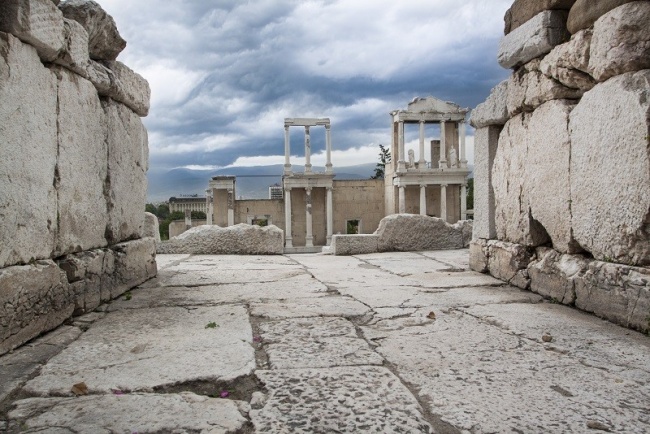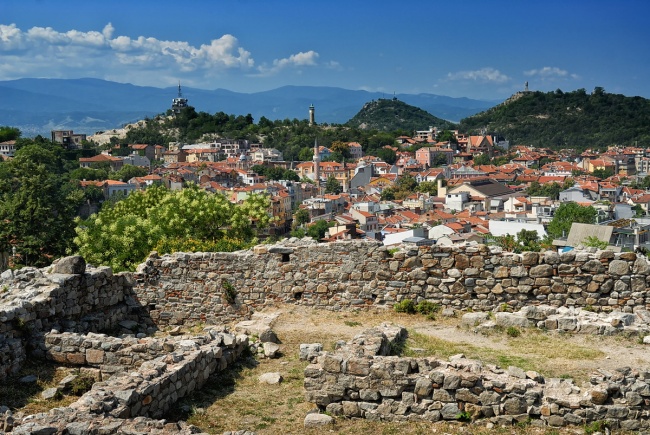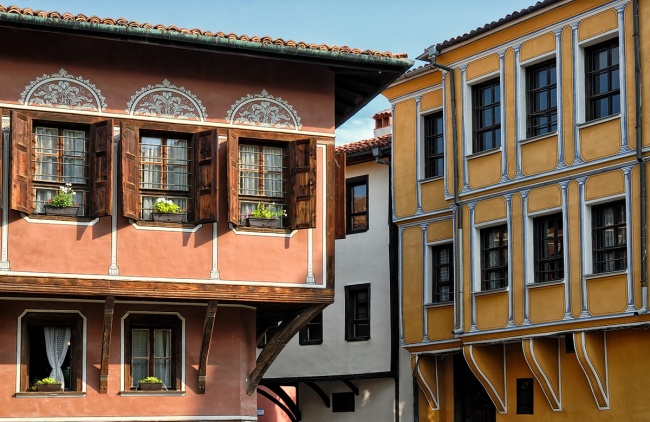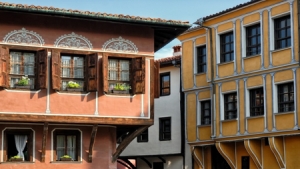ANCIENT THEATRE

The Ancient theatre of Philipoppol is one of the best-preserved ancient theatres in the World. It is located on the Southern slope of the Three Hills, in the saddle between Taksim and Dzhambaz tepe. Discovered by archaeologists from Plovdiv and reconstructed in the beginning of the 80s of XX century, the Ancient theatre of Philipoppol is among the most significant findings from the Roman period. Recently found and deciphered inscription on a monumental pedestal reveals that the theatre has been constructed in the 90s of I century A.D., when Philippolol was under the rulership of Titus Flavius Cotis – an heir of a Thracian Royal Dynasty, the high priest of the Tracian province, representative of the Metropolitan Court of Justice and a person in charge of the construction sites.
The open-air spectator’s area includes 28 concentric rows of marble seats, surrounding the stage– orchestra, which has the shape of a horseshoe with diameter 26.64 m. Apart from theatre performances, the venue was used for gladiatorial and hunting games, as well as a seat of the General Assembly of the Roman province of Thrace (Tracon koinon). It was in use until the end of IV century and had a capacity of about 6 000 spectators. There used to a lodge for the Emperor and other officials on the second row of seats above the archway.
Nowadays, the Ancient theatre is symbolical for Plovdiv and adjusted to the city’s modern cultural life. It is operating as a stage of opera, music and drama. Some of the best annual events are the International Folklore Festival, the Opera Festival "Opera Open", the Rock Festival "Sounds of Ages" and many others.
Roman Stadium

The Stadium of Philippopolis was built in the beginning of 2nd century AD during the reign Emperor Hadrian. It is situated in the Northern part of the fortified city surrounded by defence walls, in the natural terrain between Taksim Tepe and Sahat Tepe.
The facility, approximately 240 meters long and 50 meters wide, could seat up to 30 000 spectators.
According to the epigraphic and numismatic monuments games similar to the Pythian Games in Greece were held in the town. To honour the visit of the Roman emperor Caracalla in 214 the games were called Alexandrian while the games for the visit of emperor Elagabalus in 218 were called Kedrisian Games.
The games were organised by the General Assembly of the province of Thrace. In their honour the royal mint of Philippopolis coined money featuring the face of the ruling emperor as well as the types of athletic events held in the Ancient Stadium. A marble slab stone was found during the excavations of the sfendona proving that there were games celebrating the favourite man of emperor Hadrian – Antinous.
Athletes competed in two categories of age – men and boys. Agonothetes (organisers of the sport events) presided over the games. The latter started with a contest for criers and buglers. Sporting events were usually accompanied by music, poetry and art contests.
The spectators seats are tiered in 14 rows, crossed by stepped aisles down to the track. The seats are made of solid marble blocks and the front parts are decorated with stylized lion paws.
At Roman Stadium Square is exhibited the northern curved part of the Stadium (sfendona). Under the tiered rows of seats (cavea), a covered vaulted passage was found. It connected the track with a corridor dug in the terrain. The vault supported the royal seats above it. North of the corridor a section of the fortress wall built back in 2nd century AD was found. It had undergone certain readjustments in 3rd and 4th century AD. In the 4th century AD this area was crossed by an ancient aqueduct.
Like the other imperial buildings for spectacular events, the Ancient Stadium of Philippopolis had its seats of honour preserved by inscriptions in the marble blocks. Seats with Greek inscriptions were found, proving the existence of special seats for members of higher public position.
The main entrance to the Stadium is formed by masonry pillars decorated with marble pilasters and reliefs. On the pilasters there are busts of Hermes (hermai) with placed above them prize vases with palm sprays, accompanied by Hercules’ attributes – lion skin, a mace and a quiver.
There you can dive underground at the original level of the Ancient town. The space open for visitors includes a part of the track, the semi-circular part of the spectator seats (sfendona) and a panoramic wall with hypothetical reconstruction of the missing space of the facility. Some of the discovered elements of the Stadium are identified along the main street of Plovdiv.
The Roman Stadium was pronounced a national cultural value in 1995.
Archaelogical Complex Nebet Tepe

It is interesting to know when and where was the ancient town of Plovdiv founded. What is the place where the people settled and remained to live there for 8 millennia? This place is the hill known today as Nebet tepe situated on the hilltop plateau in the northern part of the three hills (Trimontium).
The earliest settlements on the territory of the city are dated back to the 6th millennium BC. There were several prehistoric settlements on this territory, but the oldest and most important one was located on hill known as Nebet tepe.
Initially the village was situated in a naturally sheltered and consolidated place on the front side of the northern hill. It gradually expanded towards the other hills to become the most significant Thracian city on the territory of Bulgaria. At that time the lands of today's Plovdiv were inhabited by the Thracian tribe Bessi. The scientists are still not sure if the name of the city at that time was Eumolpia or Pulpudeva.
In 342 BC Philip of Macedon conquers the Thracian settlement of Nebet tepe. That is the time when the Kingdom of Macedon started to dominate as the most powerful force on the Balkan Peninsula, to reach its peak during the reign of Alexander III the Macedon. During that period the name of the town was Philippopolis. After the 4th century BC the town grew and took its place as political and economic centre of Thrace.
There are different assumptions when the fortification wall was built around Philippopolis. According to some scientists the village became a city and was fortified in the early second millennium BC. There are suggestions that at this place existed a royal complex and religious centre. The latest archaeological research, however, give reasons to assume that Philippopolis became a city with urban architecture and look around the IV century BC.
During the Hellenistic period the town expanded to the East, mainly within the limits of the so called Trimontium – a massif of three hills. However, the recent archaeological researches provide evidence that at that time Philippopolis began to grow also towards the foot of the hills. At Nebet Tepe are found ruins of dwellings and fortifications dating from this period.
In the 1st century AD Philippopolis was included in the limits of the Roman Empire. As a result, its significance as a political, economical and cultural centre of the province of Thrace was reinforced. In this period it became a metropolitan city – a district centre. There were the meetings of so called koinon trakon – the general assembly of the Thracians, with representatives from all settlements in the province of Thrace.
This was also the time when the city "climbed down" from the hills to the plain. This kept the urban structure typical for the cities that were founded before the period of the Roman Empire and further developed under its management: acropolis – a high spot on the three hills, a new town with orthogonal city plan, and a square (Forum) – the administrative and social centre with the most important public buildings situated around it.
The complex of Nebet tepe continued to play an important role as an element of the fortification system of the city until the 14th century, with lots of improvements and supplements during the Antiquity and the Middle Ages. A notable finding of that later period is a reservoir of 350 cubic meters.
Small Basilica

On the territory to the East and Northeast of the Forum (Agora) of Philippopolis in the years of Early Christianity were formed neighborhoods where several Christian churches were built. In the same area were found also the ruins of a synagogue - a unique building from that period.
The ruins of the Small Early Christian basilica were found during the construction works of "Maria Louisa" Blvd. The Small basilica is situated in the eastern outskirts of the Ancient city, next to the fortification wall with a tower from 2nd - 4th century AD.
The basilica has a central nave, flanked by two aisles. It is with one apse and with a narthex. A small chapel was built to the South and a baptistery is erected just next to the Northern aisle. The overall length of the basilica, including the apse, is 20 meters, and the width is 13 meters.
The basilica was built in the second half of 5th century AD with rich architectural decorations – marble colonnades separating the aisles, marble altar wall, pulpit and synthronos. The floors were covered with rich multicolour mosaic with geometrical motifs. The mosaic includes a panel with donor inscription. Remnants of an altar table were found.
After the building had been burnt down, it was reconstructed and renovated. The outer dimensions of the building were not changed, but the floor level was raised with approximately 0.70 m. The new flooring was made of bricks. The layout of the narthex, the altar wall and the pulpit were changed and a baptistery was added next to the Northern aisle.
The baptistery had a square plan, cross pool and polychrome mosaic flooring, where Christian symbols - deer, pigeons and others - were depicted. The basilica functioned until the end of 6th century AD.
Two donor inscriptions were found during excavation works. One of them was carved on the lining marble slab from the altar of the basilica. The other was shaped in the mosaic of red tesserae on white background, just opposite to the altar apse. It mentions "patrician" and "winner", but the name was erased. Probably it was the name of Basilisk, a Byzantine Emperor in 475-476 AD, and erasing it from the mosaic shows that it was made intentionally after his dethronement.
Ancient Plovdiv Architectural and Historical Reserve

Ancient Plovdiv Architectural and Historical Reserve (The Old Town) is located in the Central part of the city of Plovdiv on the Three Hills (Nebet Tepe, Taksim Tepe and Dzhambaz Tepe) and covers an area of about 35 ha. It was formed due to the continuous life over the centuries – from Prehistoric, Thracian, Hellenic, Roman, Late-ancient, Medieval, National Revival, and Post-Liberation periods to present days. The combination of the prevailing Antiquity, Middle Ages and Revival in an independent core within the modern city is one of a kind for our country.
From the Roman and the Late-ancient period in the Old Town have been best preserved the Ancient Theatre, the Ancient Forum, the Roman Stadium, Early Christian basilicas, public and private buildings, pipelines, street network and parts of the fortress walls, constructed in the Antiquity and the Middle Ages.
From the National Revival period the authentic architecture of houses as well as several churches and school buildings have been preserved. The residential buildings are divided into two main groups. The first group of houses corresponds to the mountain asymmetrical type, but it has been expanded and enriched for the needs of the urban life. The second group is the so-called “Plovdiv symmetrical urban house”. This group of buildings is characterized by a unique national interpretation of the European baroque.
See the other TOP 5 places HERE






